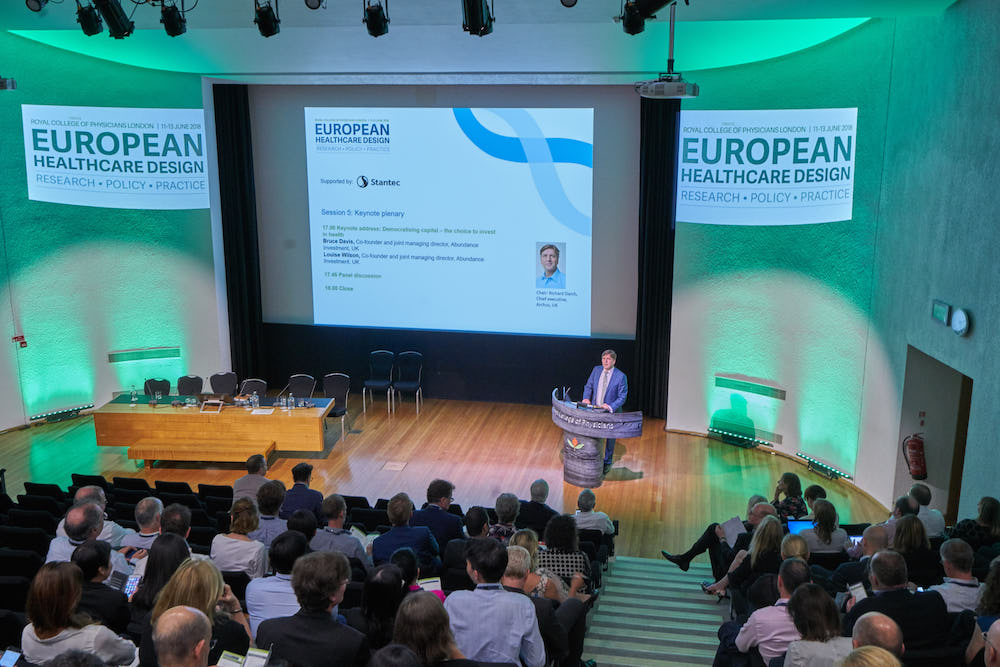The deadline for Early Bird saver registrations for the 5th European Healthcare Design Congress & Exhibition 2019 has been extended until Tuesday 14 May.
With the plenary theme of 'Blurring the boundaries: designing place-based health systems', this year's congress will explore how the global shift towards population- and place-based health systems are gaining momentum, facilitated by advances in science and technology. The Congress, which will take place from Monday 17 June to Wednesday 19 June 2019, at the Royal College of Physicians, London, features eight dedicated streams, four on each day – download our 24-page Preliminary Programme for all the details.
Blurring the boundaries
Accessible health systems that provide timely, affordable, high-quality care are a cohesive, binding force. The future promises huge benefits but the intervening journey may test our political, economic and social fabric. Amid such upheaval, can our health systems meet both our current needs and future demands?
Ten years since the global financial crisis, economic and social insecurity remains rife amid a widening gulf in wealth distribution across the world. Consequently, societies are polarising in many countries and established political orders and values are fracturing. Never has it seemed more timely to improve and transform health systems that provide security and underpin economic productivity at the same time as continuing to demonstrate the value of investing in science and technology for the public good.
We’re also at the beginning of the fourth industrial revolution, which is blurring the lines between the physical, digital and biological worlds. As advances in AI and personalised medicine create enormous benefits in diagnosis, pharma and treatment, as importantly, we now have the digital capacity to connect and integrate healthcare systems, allowing population and place-based models of care to evolve fully.

Providing an interdisciplinary global forum for researchers, practitioners and policy advisors, the 5th European Healthcare Design 2019 Congress & Exhibition will be held on 17–19 June, 2019 at the Royal College of Physicians in London, UK. Organised by Architects for Health and SALUS Global Knowledge Exchange, the Congress adopts a whole-system approach to redesigning international health systems, services and infrastructure through the exchange of knowledge, research and best practice.
Changing relationships
Globally, the shift towards population- and place-based health systems is gaining momentum. Providers can no longer focus only on treating the sick and infirm in the traditional hospital, but must partner with other sectors, such as housing, transport, urban planning and the workplace to design healthier communities, helping people to stay well by improving opportunities for physical activity, access to nutritious food and social and cultural interaction. As the boundaries between public health and healthcare systems blur with personal responsibility and lifestyles, a redefinition of building typologies and reclassification of funding streams is needed to support place-based systems of care.
Meanwhile, digital connectivity is changing the traditional patient- physician relationship. How will this and other technologically led advances change our healthcare architecture? The interplay between technological change, clinical advances and patient-centred design and health creates new standards and, potentially, exciting forms for operating rooms, intensive care and emergency units, cancer facilities, and laboratories.
A new healthcare architecture
The definition of healthcare architecture is widening; as medicine and social care share space in community settings, so traditional building typologies become redundant. As our high-street shops fall empty, their replacement with innovative social and healthcare centres that also provide wellness-based services, may help sustain town centres. Equally, locating these facilities in places with high footfall such as transport hubs, will create opportunities to join up public health and healthcare services where it is needed, improving access, enabling earlier diagnosis, and creating more efficient care pathways.
The arts also have a role to play in this new blurred world – helping to tackle social isolation, providing cognitive stimulation, reducing stress, an supporting rehabilitation. We can use the fusion of art and digital technology in the real and virtual worlds to improve outcomes and enhance staff and patient experience.
Innovation in sustainable development
Many healthcare facilities have been limited historically by being single-use developments. As boundaries blur, there are real opportunities for creating sustainable mixed-use communities on green campus sites. These can be concrete expressions of the new taxonomy of healthcare and social architecture, and communicate, in built form, new models for integrated and place-based care.
The design of every building and care system must address the sustainable use of energy, and material and human resources in capital; even more important is a sustainable revenue stream, which should extend to procurement processes and commercial business cases. And, as climate change leads to ever-greater weather extremes, we must develop innovative solutions for designing in imperilled environments. In all senses of the term, we welcome examples of genuine design innovation in sustainable development.
Download the Preliminary Programme now for comprehensive details, including programme listings, speaker profiles, the poster gallery, and three exciting study tours to innovative UK health facilities. Online registration for the 5th European Healthcare Design 2019 Congress is now open, with our Early Bird saving running until 11 April.

